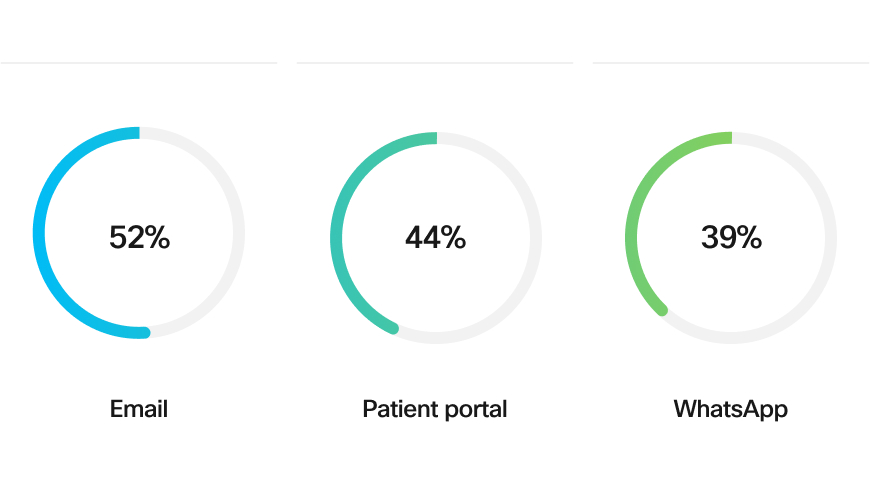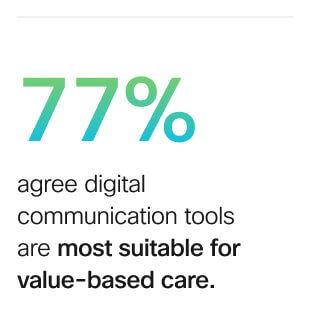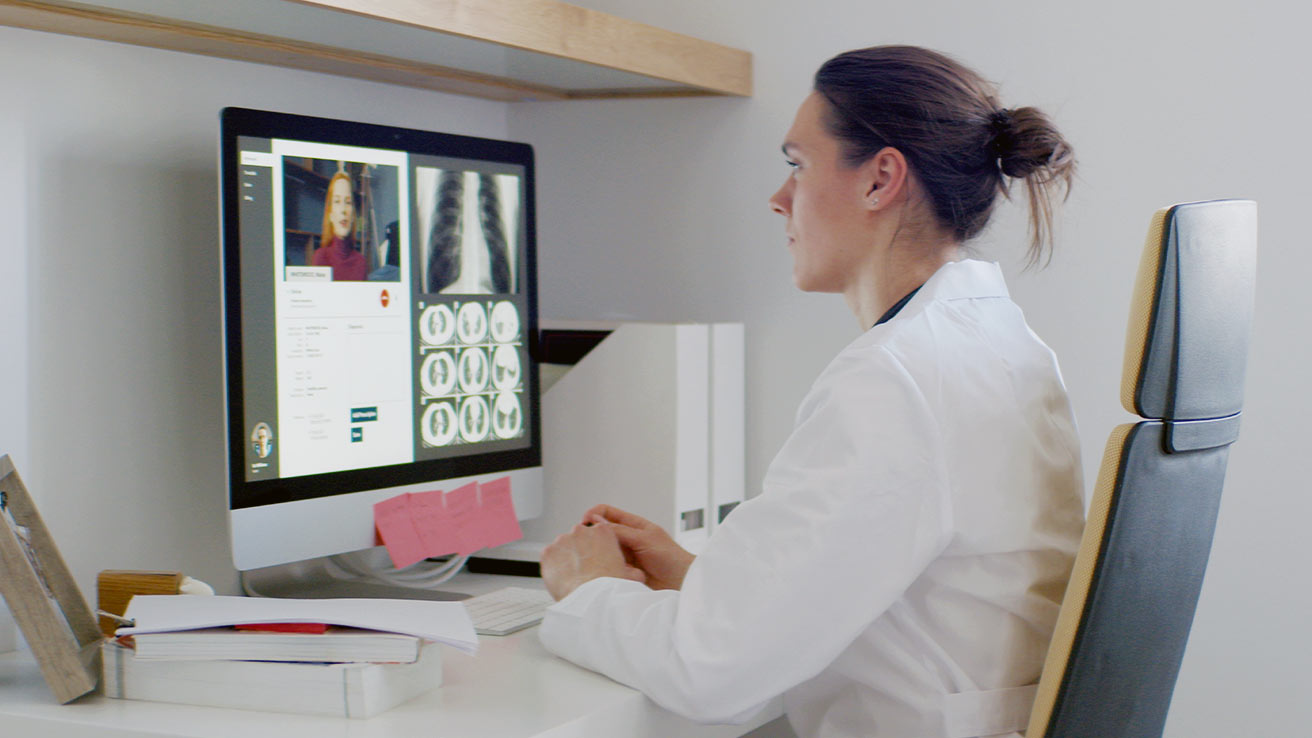Survey results demonstrate digital communication tools contribute to value-based healthcare.
To understand how digital communication channels have impacted the patient experience, we surveyed 2,000 individuals who had seen their physician in the past two years.

Contents
A positive patient experience in healthcare relies on many factors, including how physicians communicate with their patients, a question with even more importance as healthcare providers transition from fee-for-service to value-based care.
To better understand how the exponential growth of digital communication channels has impacted the patient experience, we surveyed 2,000 individuals who had seen their physician in the past two years.
We asked five core questions about the use of digital communication tools including SMS, portals and instant messaging apps and preferences regarding value-based versus fee-for-service care. We’ve summarized the key findings to help providers with refining their digital engagement strategies.
Benefits of digital communication tools
The survey results indicate that most patients definitely see the benefits of using digital communication tools to communicate with their healthcare providers and for value-based care.
76% of respondents indicated digital communication tools improve the patient experience, although using these tools is not a factor in selecting a healthcare provider.
77% agree that communicating with their healthcare providers using digital communication tools supports value-based care.
Email (52%) and patient portals (44%) were the top two digital communication tools preferred by respondents when communicating with their healthcare providers. Over a third (34%) of patients prefer SMS, reinforcing that it remains an important HIPAA-compliant channel, providing the right safeguards are put in place.
Somewhat surprisingly, a significant number of respondents said they would prefer to use WhatsApp (39%) and social media direct messaging (37%) for communicating with their provider.
Insights from healthcare leaders
We asked a few healthcare leaders what they thought about the survey results, and their opinions are below.
“These findings demonstrate the importance of digital engagement to improve patient experience,” says H. Stephen Lieber, former HIMSS CEO and principal of Avisos Partners, LLC. “Only 6% of the respondents don't use digital channels when communicating with healthcare providers, which shows a considerable shift in how Americans communicate with their medical professionals.
“However, despite this, 61% would still choose a provider who did not offer digital communications. This indicates that digital communication is still not a ‘required’ component in a patient/practitioner relationship.”

“Patients like digital communication tools because they are easy to use. A patient can book an appointment or send a quick message to their provider, a time-saving advantage with often limited time in a day for these tasks,” says Brian DeCicco, manager of IT development at Kaleida Health in Buffalo, NY.
“For hospital staff, digital communication tools reduce inbound and outbound phone calls and wait times for patients confirming or cancelling their appointments. These efficiencies then allow staff to spend more time on patient-centered or other tasks and increase cost savings for the organization.”
Improved Patient Outcomes
Digital communication options also help improve patient outcomes, which is fundamental to value-based care, explains Natasha Ramontal, DHSc, RN, HIMSS digital health strategist – community outcomes, North America.
“Successful communication is central to value-based care,” says Dr. Ramontal. “Digital communication tools are pivotal in this approach, underscoring their significance in fostering patient engagement and enhancing overall healthcare delivery. By promoting these value-based goals, digital communication tools substantially contribute to the transformation of healthcare, aligning it with the broader goal of achieving better patient outcomes and overall wellness.”
This sentiment is also echoed by healthcare providers. “Digital channels are rapidly weaving themselves into the fabric of quality care delivery, offering a tapestry of benefits for both patients and providers,” comments Zafar Chaudry, MD, MS, MIS, MBA, Sr. Vice President, Chief Digital Officer and CIO at Seattle Children's Hospital.
“From seamless communication platforms fostering informed dialogue to remote monitoring tools enabling early intervention, technology empowers patients to actively participate in their health journey. Additionally, electronic medical records facilitate efficient care coordination across diverse specialties, while data analytics unlock insights for personalized treatment plans. While the human touch remains irreplaceable, digital channels undoubtedly enhance accessibility, efficiency, drive value and ultimately, the quality of care we receive.”
Multiple Digital Communication Tools in Use
As for which digital communication tools survey respondents preferred, they selected email (52%), a patient portal (44%), and WhatsApp (39%) as the top three choices.

An unexpected outcome for this question was the choice of WhatsApp because the instant messaging app is not HIPAA-compliant. However, this response reinforces the importance and growth of digital channels that patients use to communicate and socialize on daily. The convenience and familiarity of these instant messaging apps also reflect a broader trend where people expect seamless connectivity across all aspects of their lives and now desire a similar experience when engaging about their healthcare.
This shift toward digital communication channels in healthcare can be viewed positively for both patients and providers. Patients benefit from the convenience of instant communication, as well as the ability to engage with healthcare providers in a manner similar to their interactions with friends and family. For providers, digital channels offer trackability, ensuring that important health information reaches patients securely and much more efficiently than traditional channels such as post.
Value-based care

Most respondents said the value-based care model is better for patients than fee-for-service (61%), 17% weren’t sure, and 16% indicated the fee-for-service model is better.
Approximately 8 out of 10 respondents (77%) agreed that using digital communications tools, such as SMS/text, social media messaging, a patient portal, and others, when communicating with their healthcare provider is most suitable for value-based care. Another 17% of respondents did not agree or disagree.
These results align with the core principles of value-based care, emphasizing the importance of digital engagement in proactive outreach to improve outcomes and transition towards a preventative healthcare model rather than a reactive one focused on treatment.
Webex insights
These survey results reveal that a one-size-fits-all approach is no longer appropriate for patient engagement. With healthcare costs rising, patient expectations mirror the same convenience, personalization, and access as other service sectors. Providers are now competing by experience, including on-demand anytime, anywhere engagement that digital channels offer.
Our HIPAA compliant digital communications platform, Webex Connect, enables real-time, two-way conversations between healthcare providers and patients, on their channel of choice, which is a vital component of value-based care. The ability to connect remotely for telehealth visits or communicate with secure text messaging means patients can interact with their care team on a convenient and secure platform.
Our practical guide outlines the roadmap to digital transformation, featuring real-life results achieved by healthcare providers and showcasing the positive impact on patient engagement.



